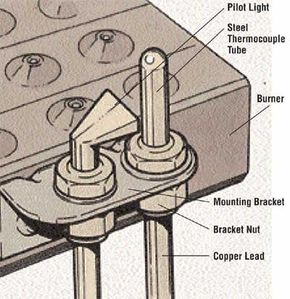Repairing Pilot Lights and Thermocouples
Older gas appliances may have pilot lights that provide instant ignition when the gas is turned on. The pilot light is a small open flame that is fed by a steady flow of gas.
Problems occur when the gas flow is obstructed or misdirected, or when the pilot is blown out. In newer appliances, ignition may be achieved by a sparking device or a glow bar instead of a pilot light. In furnaces and water heaters, and in some ranges and dryers, the pilot light is accompanied by a safety device called a thermocouple -- a heat sensor that turns the gas off if the pilot flame is extinguished. Newer gas appliances have igniters that start the pilot light as needed.
Advertisement
Caution: Some older appliances may not have a safety device to turn the gas off when the pilot is extinguished. With any gas-fired appliance, if a strong smell of gas is present, do not try to relight the pilot or turn the appliance on, or turn any lights on or off. Get out of the house, leaving the door open, and call the gas company or the fire department immediately to report a leak.
Pilot Lights
A correctly adjusted pilot flame is steady and blue, and stands between 1/4 and 1/2 inch high. If the flame goes out repeatedly, it may be getting too little air; if it's yellow at the tip, it's getting too much air. To correct either condition, turn the pilot adjustment screw slightly, as directed by the manufacturer. When a pilot goes out, relighting it is simple:
Step 1: If there is a gas valve at the pilot, turn the valve to the OFF position and wait at least three minutes to let any built-up gas dissipate. After three minutes, turn the valve to the PILOT position. If there is a safety or reset button, push the button, and keep it depressed.
Step 2: Hold a lighted match to the pilot orifice and turn the gas valve to the ON position. Then, when the pilot is burning brightly, release the reset button. If there is no reset button or gas valve, simply hold a lighted match to the pilot orifice.
Step 3: If the pilot flame won't stay lit after several tries, it should be adjusted by a professional. Don't try to adjust the mechanism or tamper with the gas line.

Thermocouples
If the appliance has a thermocouple, the problem may be a faulty thermocouple. The thermocouple, which operates as a safety device, turns the gas supply off when the pilot light goes out. It consists of a heat sensor connected to a solenoid; when the sensor is not heated by the pilot flame, the solenoid closes the gas supply line. When a thermocouple fails, the pilot light won't stay lighted. A burned out or broken thermocouple should be replaced. To replace a thermocouple:
Step 1: Unscrew the copper lead and the connection nut inside the threaded connection to the gas line.
Step 2: Under the mounting bracket at the thermocouple tube, unscrew the bracket nut that holds the tube in place.
Step 3: Insert a new thermocouple into the hole in the bracket, steel tube facing up and copper lead down.
Step 4: Under the bracket, screw the bracket nut over the tube. Push the connection nut to the threaded connection where the copper lead connects to the gas line. Make sure the connection is clean and dry.
Step 5: Screw the nut tightly into place, but do not overtighten it. Both the bracket nut and the connection nut should be only a little tighter than if hand-tightened.
In our final section, we will conclude our discussion of repairing major appliances with a detailed examination of -- of course -- motors. Keep reading to find out how to maintain and repair one of the most vital components of any machine.
